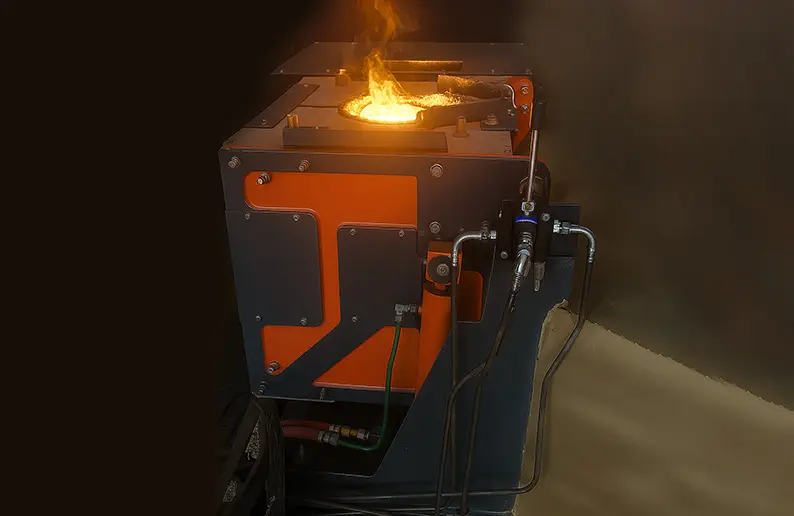Introduction
Metal casting remains a foundational process in the global manufacturing sector, and the foundry industry stands at the heart of this transformative craft. As foundries shift toward greener, more cost-effective technologies, the induction furnace for foundry applications has emerged as a preferred solution. By replacing traditional combustion-based systems, induction furnaces offer precision, cleaner operations, and energy efficiency that align with modern industry demands. This article explores how induction melting technology is shaping the future of the foundry sector.
What is an Induction Furnace for Foundry?
An induction furnace for foundry is a highly efficient melting device that uses electromagnetic induction to convert electrical energy into heat for melting metal. It is especially designed to meet the continuous and intensive demands of foundry operations. Unlike cupola or gas-fired furnaces, foundry induction furnaces do not burn fossil fuels and instead use a non-contact heating process that delivers cleaner and more consistent results. They are ideal for melting ferrous and non-ferrous alloys in a controlled and efficient manner.

How Induction Melting Works in Foundries
Induction melting in foundries operates on the principle of electromagnetic induction. Alternating current (AC) is passed through a copper coil, creating a magnetic field. When metal is placed inside a crucible surrounded by this coil, eddy currents are induced within the metal, causing it to heat and melt. This non-contact method provides rapid, uniform heating and allows for precise control over melting temperatures—an essential requirement for alloy integrity and repeatable casting outcomes.
To better visualize this technology in context, the following illustrations showcase how induction melting systems are integrated within a modern foundry environment:
Key Advantages of Using Induction Furnace in Foundry Industry
Foundry induction melting furnaces offer a variety of benefits that make them indispensable in modern casting environments:
Energy Efficiency: Direct heating results in lower power consumption.
Precision Control: Ensures repeatable melting cycles with consistent temperature.
Environmental Safety: No combustion gases or particulates.
Faster Melt Times: Higher throughput and productivity.
Enhanced Safety: Reduced exposure to flames, smoke, or molten splatter.
| Feature | Traditional Foundry Furnaces | Induction Foundry Furnaces |
| Heating Method | Combustion (e.g., coke, gas, oil) | Electromagnetic Induction |
| Energy Efficiency | Low to moderate | High |
| Melting Speed | Slower melting cycle | Faster and uniform melting |
| Environmental Impact | High emissions and heat loss | Low emissions and energy waste |
| Temperature Control | Less precise control | High precision |
| Workplace Safety | Risk from open flames and fumes | Enclosed system, safer operation |
| Maintenance Requirements | Frequent cleaning and upkeep | Lower due to enclosed design |
| Emission Output | High CO₂ and particulate matter | Minimal emissions |
| Operational Cost | Higher over time (fuel-based) | Lower due to energy efficiency |
| Automation Compatibility | Limited or manual | Easily integrated with PLC/IoT |
Comparison: Traditional Foundry Furnaces vs. Induction Foundry Furnaces.
Industrial Applications and Use Cases
Foundry induction furnaces are employed across various sectors. In iron and steel foundries, they are used for producing castings such as automotive components, pump housings, machine tools, and valve bodies. Non-ferrous applications include melting of copper, aluminum, and bronze for casting parts in aerospace, electrical, and defense sectors. These systems are also extensively used in recycling operations to reprocess scrap metal efficiently and with minimal environmental impact.
Configuration Considerations for Foundries
When selecting or designing an induction furnace for foundry use, the following factors should be evaluated:
Crucible Capacity: Scalable from 50 kg to 30 tons.
Frequency Range: Low to medium frequency depending on metal type.
Cooling System: Options for air- or water-cooled coils.
Automation: Integration with PLCs, SCADA systems, and Industry 4.0 protocols.
| Configuration Feature | Description |
| Crucible Capacity | Typically ranges from 50 kg to 3+ tons depending on foundry size and metal type |
| Power Supply Frequency | Low to medium frequency (50 Hz to 3 kHz) based on metal properties and desired penetration depth |
| Cooling System | water-cooled induction coils for thermal stability |
| Refractory Material | Silicon Carbide and High-grade refractory linings (e.g., silica, alumina, magnesia) for thermal and chemical resistance |
| Automation Integration | PLC, SCADA, and Industry 4.0 ready systems for real-time monitoring and control |
| Pouring Mechanism | Hydraulic Tilting furnace |
| Magnetic Shunt Option | Optional inclusion for energy efficiency and reduced magnetic flux losses |
| Melting Speed Range | Rapid melting capabilities typically within 15–90 minutes depending on load and power |
| Temperature Monitoring | Digital thermocouples or optical pyrometers for precise temperature control |
| Control Panel Interface | Touchscreen HMI or digital control panels with safety interlocks and diagnostics |
Key Configuration Features for Foundry Induction Furnaces..
Conclusion
An induction furnace for foundry is not just a melting solution—it is an essential asset for foundries aiming to enhance quality, reduce operational costs, and align with environmental standards. From superior thermal control to efficient scrap recycling, induction melting furnaces deliver transformative advantages in metal casting. Explore our full range of foundry induction furnace systems designed to meet diverse industrial needs and performance standards.
Our Videos
Watch our Videos

